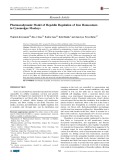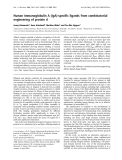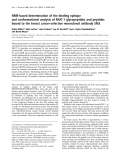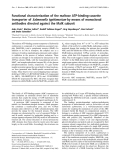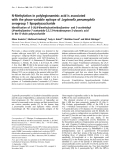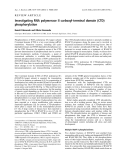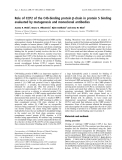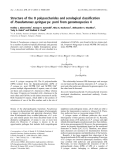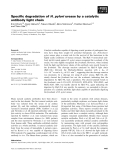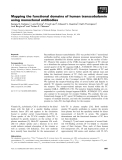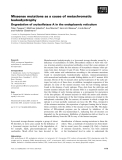
Monoclonal antibodies
-
Kháng thể đơn dòng là kháng thể kháng một kháng nguyên nào đó được tạo ra từ một dòng tế bào lymphocyte B trong điều kiện in vitro. Và để hiểu rõ hơn về lĩnh vực này, mời các bạn tham khảo bài giảng Sản xuất kháng thể đơn dòng (Monoclonal antibodies-Mab) sau.
 53p
53p  maiyeumaiyeu09
maiyeumaiyeu09
 14-09-2016
14-09-2016
 225
225
 25
25
 Download
Download
-
Hepcidin (H25) is a hormone peptide synthesized by the liver that binds to ferroportin and blocks iron export. In this study, H25 was inhibited by administration of single and multiple doses of an anti-H25 monoclonal antibody Ab 12B9m in cynomolgus monkeys. The objective of this analysis was to develop a pharmacodynamic model describing the role of H25 in regulating iron homeostasis and the impact of hepcidin inhibition by Ab 12B9m. Total serum H25 and Ab 12B9m were determined in each animal. Corresponding measurements of serum iron and hemoglobin (Hb) were obtained.
 15p
15p  caothientrangnguyen
caothientrangnguyen
 09-05-2020
09-05-2020
 13
13
 1
1
 Download
Download
-
P-glycoprotein (Pgp), a membrane pump often responsible for the multidrug resistance of cancer cells, undergoes conformational changes in the presence of substrates/modulators, or upon ATP depletion, reflected by its enhanced reactivity with the UIC2 monoclonal antibody. When the UIC2-shift was elicited by certain modulators (e.g. cyclosporin A or vinblastine, but not with verapamil or Tween 80), the subsequent binding of other monoclonal anti-Pgp Ig sharing epitopes with UIC2 (e.g. MM12.10) was abolished [Nagy, H., Goda, K., Arceci, R., Cianfriglia, M., ´ Mechetner, E. & Szabo Jr, G.
 6p
6p  system191
system191
 01-06-2013
01-06-2013
 62
62
 7
7
 Download
Download
-
Affinity reagents capable of selective recognition of the different human immunoglobulin isotypes are important detection and purification tools in biotechnology. Here we describe the development and characterization of affinity proteins (affibodies) showing selective binding to human IgA. From protein libraries constructed by combinatorial mutagenesis of a 58-amino-acid, three-helix bundle domain derived from the IgG-binding staphylococcal protein A, variants showing IgA binding were selected by using phage display technology and IgA monoclonal antibodies (myeloma) as target molecules. ...
 9p
9p  system191
system191
 01-06-2013
01-06-2013
 39
39
 3
3
 Download
Download
-
Mucin glycoproteins on breast cancer cells carry shortened carbohydrate chains. These partially deglycosylatedmucin 1 (MUC-1) structures are recognized by the monoclonal antibody SM3, which is being tested for its diagnostic utility. We used NMR spectroscopy to analyze the binding mode and thebindingepitopeof peptideandglycopeptideantigens to the SM3 antibody. The pentapeptide PDTRP and the glycopentapeptide PDT(O-a-D-GalNAc)RP are known lig-ands of the monoclonal antibody.
 12p
12p  research12
research12
 29-04-2013
29-04-2013
 42
42
 3
3
 Download
Download
-
Hybridomas are cells that have been engineered to produce a desired antibody in large amounts. To produce monoclonal antibodies, Bcells are removed from the spleen of an animal that has been challenged with the relevant antigen. These B-cells are then fused with myeloma tumor cells that can grow indefinitely in culture (myeloma is a B-cell cancer). This fusion is performed by making the cell membranes more permeable. The fused hybrid cells (called hybridomas), being cancer cells, will multiply rapidly and indefinitely and will produce large amounts of the desired antibodies.
 7p
7p  zingzing09
zingzing09
 24-04-2013
24-04-2013
 72
72
 4
4
 Download
Download
-
ThemaltoseATP-binding cassette transporter ofSalmonella typhimurium is composed of a membrane-associated com-plex (MalFGK2) and a periplasmic receptor (MalE). In addition to its role in transport, the complex acts as a repressor ofmaltose-regulatedgene expressionand is subject to inhibition in the process of inducer exclusion. These activities are thought to be mediated by interactions of the ATPase subunit, MalK, with the transcriptional activator, MalT, and nonphosphorylated enzyme IIA of the glucose phosphotransferase system, respectively. ...
 12p
12p  research12
research12
 23-04-2013
23-04-2013
 36
36
 3
3
 Download
Download
-
Previously, a phase-variable epitope was detected in the virulent wild-type strain RC1 of Legionella pneumophila serogroup 1 subgroup OLDA using a lipopolysaccharide-speci®c monoclonal antibody, mAb 2625 [LuÈneberg, E., ZaÈhringer,U.,Knirel,Y.A., Steinmann,D.,Hartmann,M., Steinmetz, I., Rohde, M., Kohl, J. & Frosch, M. (1998) J. Exp. Med.188, 49±60]. In the present study, an isogenic mutant strain, termed 5215, was constructed by deletion of genes involved in the biosynthesis of the mAb 2625 epitope....
 13p
13p  research12
research12
 23-04-2013
23-04-2013
 32
32
 3
3
 Download
Download
-
An arti®cial peroxidase-like hemoprotein has been obtained by associating a monoclonal antibody, 13G10, and its iron(III)±a,a,a,b-meso-tetrakis(ortho-carboxyphenyl)por-phyrin [Fe(ToCPP)] hapten. In this antibody, about two-thirds of the porphyrinmoiety is inserted in the binding site, its ortho-COOH substituents being recognized by amino-acids of the protein, and a carboxylic acid side chain of the protein acts as a general acid base catalyst in the heterolytic cleavage of the O±O bond of H2O2, but no amino-acid res-idue is actingas anaxial ligandof the iron....
 11p
11p  research12
research12
 23-04-2013
23-04-2013
 36
36
 2
2
 Download
Download
-
Phosphorylation of RNA polymerase II’s largest subunit C-terminal domain (CTD) is a key event during mRNA metabolism. Numerous enzymes, including cell cycle-dependent kinases and TFIIF-dependent phosphatases tar-get the CTD. However, the repetitive nature of the CTD prevents determination of phosphorylated sites by conven-tional biochemistry methods. Fortunately, a panel of monoclonal antibodies is available that distinguishes between phosphorylated isoforms of RNA polymerase II’s (RNAP II) largest subunit....
 12p
12p  tumor12
tumor12
 20-04-2013
20-04-2013
 51
51
 2
2
 Download
Download
-
A high-affinity monoclonal antibody (M27), raised against the human thrombin–antithrombin complex, has been identifiedand characterized. The epitope recognizedbyM27 was located to the linear sequence FIREVP (residues 411– 416), located in the C-terminal cleavage peptide of anti-thrombin.This regionoverlaps, by two residues, theputative binding site of antithrombin for the serpin–enzyme complex receptor.
 11p
11p  tumor12
tumor12
 20-04-2013
20-04-2013
 37
37
 4
4
 Download
Download
-
Neutralizing and protective monoclonal antibodies (mAbs) were used to fine-map the highlyconserved hemagglutinin noose epitope (H379–410, HNE) of themeasles virus. Short peptides mimicking this epitope were previouslyshown to induce virus-neutralizing antibodies [El Kasmi et al. (2000) J. Gen. Virol.81, 729–735]. The epitope contains three cys-teine residues, two of which (Cys386 and Cys394) form a disulfide bridge critical for antibodybinding.
 13p
13p  tumor12
tumor12
 20-04-2013
20-04-2013
 37
37
 5
5
 Download
Download
-
Therehas longbeenconjectureover thedegree towhichthere may be structural and functional heterogeneity in the tetra-mericserineproteasetryptase(EC 3.4.21.59), amajor mediator of allergic inflammation. We have applied 2D gel electrophoresis to analyze the extent, nature, and variability of thisheterogeneity inlysatesofmast cells isolatedfromlung and skin, and in preparations of purified tryptase. Gels were silver stained, or the proteins transferred to nitrocellulose blots and probed with either tryptase-specific monoclonal antibodies or various lectins. ...
 14p
14p  tumor12
tumor12
 20-04-2013
20-04-2013
 41
41
 3
3
 Download
Download
-
Complement regulator C4b-binding protein (C4BP) and the anticoagulant vitamin K-dependent protein S form a high affinity complexin human plasma. C4BP is composed of sevena-chains and a uniqueb-chain, each chain comprising repeating complement control protein (CCP) modules. The binding site for protein S mainly involves the first of the threeb-chain CCPs (CCP1). However, recently it has been suggested that CCP2 of theb-chain also contributes to the binding of proteinS.
 8p
8p  tumor12
tumor12
 20-04-2013
20-04-2013
 35
35
 2
2
 Download
Download
-
Strains ofPseudomonas syringaepv. porri are characterized by a number of pathovar-specific phenotypic and genomic characters and constitute a highly homogeneous group. Using monoclonal antibodies, they all were classified in a novelP. syringaeserogroup O9. The O polysaccharides (OPS) isolated from the lipopolysaccharides (LPS) of P. syringaepv.
 8p
8p  tumor12
tumor12
 20-04-2013
20-04-2013
 38
38
 3
3
 Download
Download
-
Plasminogen activator inhibitor-1 (PAI-1) belongs to the serpin family of serine proteinase inhibitors. Serpins inhibit their target proteinases by an ester bond being formed between the active site serine of the proteinase and the P1 residue of the reactive centre loop (RCL) of the serpin, fol-lowed by insertion of the RCL intob-sheet A of the serpin. Concomitantly, there are conformational changes in the flexible joint region lateral tob-sheet A.
 8p
8p  fptmusic
fptmusic
 16-04-2013
16-04-2013
 29
29
 2
2
 Download
Download
-
Catalytic antibodies capable of digesting crucial proteins of pathogenic bac-teria have long been sought for potential therapeutic use. Helicobacter pyloriurease plays a crucial role for the survival of this bacterium in the highly acidic conditions of human stomach. The HpU-9 monoclonal anti-body (mAb) raised againstH. pyloriurease recognized thea-subunit of the urease, but only slightly recognized theb-subunit. However, when isolated both the light and the heavy chains of this antibody were mostly bound to the b-subunit....
 9p
9p  fptmusic
fptmusic
 11-04-2013
11-04-2013
 45
45
 3
3
 Download
Download
-
Báo cáo khoa học: Mapping the functional domains of human transcobalamin using monoclonal antibodies
Recombinant human transcobalamin (TC) was probed with 17 monoclonal antibodies (mAbs), using surface plasmon resonance measurements. These experiments identified five distinct epitope clusters on the surface of holo-TC. Western blot analysis of the CNBr cleavage fragments of TC allowed us to distribute the epitopes between two regions, which spanned either the second quarter of the TC sequence GQLA…TAAM(103–198) or the C-ter-minal peptide LEPA…
 12p
12p  fptmusic
fptmusic
 11-04-2013
11-04-2013
 48
48
 3
3
 Download
Download
-
Plasmin(ogen) kringles 1 and 4 are involved in anchorage of plasmin(ogen) to fibrin and cells, an essential step in fibrinolysis and pericellular proteo-lysis. Their contribution to these processes was investigated by selective neutralization of their lysine-binding function. Blocking the kringle 1 lysine-binding site with monoclonal antibody 34D3 fully abolished binding and activation of Glu-plasminogen and prevented both fibrinolysis and plasmin-induced cell detachment-induced apoptosis.
 14p
14p  fptmusic
fptmusic
 11-04-2013
11-04-2013
 38
38
 2
2
 Download
Download
-
Metachromatic leukodystrophy is a lysosomal storage disorder caused by a deficiency of arylsulfatase A (ASA). Biosynthesis studies of ASA with vari-ous structure-sensitive monoclonal antibodies reveal that some epitopes of the enzyme form within the first minutes of biosynthesis whereas other epi-topes form later, between 10 and 25 min. When we investigated 12 various ASAs, with amino acid substitutions according to the missense mutations found in metachromatic leukodystrophy patients, immunoprecipitation with monoclonal antibodies revealed folding deficits in all 12 mutant ASA enzymes....
 0p
0p  awards
awards
 06-04-2013
06-04-2013
 25
25
 2
2
 Download
Download
CHỦ ĐỀ BẠN MUỐN TÌM









